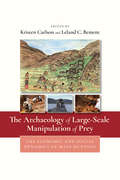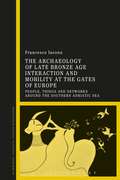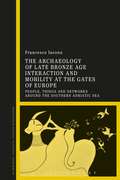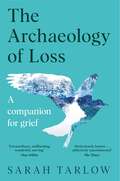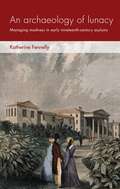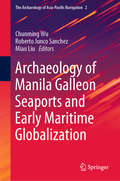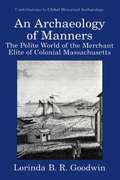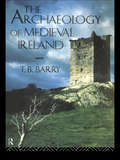- Table View
- List View
An archaeology of innovation: Approaching social and technological change in human society (Social Archaeology and Material Worlds)
by Catherine J. FriemanAn archaeology of innovation is the first monograph-length investigation of innovation and the innovation process from an archaeological perspective. It interrogates the idea of innovation that permeates our popular media and our political and scientific discourse, setting this against the long-term perspective that only archaeology can offer. Case studies span the entire breadth of human history, from our earliest hominin ancestors to the contemporary world. The book argues that the present narrow focus on pushing the adoption of technical innovations ignores the complex interplay of social, technological and environmental systems that underlies truly innovative societies; the inherent connections between new technologies, technologists and social structure that give them meaning and make them valuable; and the significance and value of conservative social practices that lead to the frequent rejection of innovations.
An archaeology of innovation: Approaching social and technological change in human society (Social Archaeology and Material Worlds)
by Catherine J. FriemanAn archaeology of innovation is the first monograph-length investigation of innovation and the innovation process from an archaeological perspective. It interrogates the idea of innovation that permeates our popular media and our political and scientific discourse, setting this against the long-term perspective that only archaeology can offer. Case studies span the entire breadth of human history, from our earliest hominin ancestors to the contemporary world. The book argues that the present narrow focus on pushing the adoption of technical innovations ignores the complex interplay of social, technological and environmental systems that underlies truly innovative societies; the inherent connections between new technologies, technologists and social structure that give them meaning and make them valuable; and the significance and value of conservative social practices that lead to the frequent rejection of innovations.
The Archaeology of Interdependence: European Involvement in the Development of a Sovereign United States (SpringerBriefs in Archaeology #1)
by Douglas C ComerThe publication explores the ways in which archaeological research can inform us about the manner and motives of European involvement in the development of a sovereign United States. The five chapters focus on different archaeological sites (four terrestrial sites) and each consider the special ways in which archaeology can contribute to our understanding of the cultural dynamics that set the historic course of events in motion that culminated in United States sovereignty. An introduction and conclusion examine how the material culture that is the central focus of archaeological research should be preserved, managed, and interpreted. While much is known through historical documents, this volume seeks to enrich, modify, and challenge the written record by attention to the archaeological remains. The scale of analysis ranges from the artifact through the site to the landscape. Chapters address the changing relationships between specific European countries and the United States as indicated by the presence of artifacts or types of artifacts (e.g., weapons, domestic, architectural) made or traded by other countries during different time periods; an analysis of “space syntax” seen at battlefields or fortifications; the importance of conceptually reconstructing terrain crossed by troops or at battlefields. The Archaeology of Interdependence: European Involvement in the Development of a Sovereign United States presents innovative investigations of what material culture at all scales might tell us about the political, economic, or ideological relationships among cultures that corroborates, contradicts, or enriches the historic record.
The Archaeology of Iran from the Palaeolithic to the Achaemenid Empire: From The Palaeolithic To The Achaemenid Empire (Routledge World Archaeology)
by Roger Matthews Hassan Fazeli NashliThe Archaeology of Iran from the Palaeolithic to the Archaemenid Empire is the first modern academic study to provide a synthetic, diachronic analysis of the archaeology and early history of all of Iran from the Palaeolithic period to the end of the Achaemenid Empire at 330 BC. Drawing on the authors’ deep experience and engagement in the world of Iranian archaeology, and in particular on Iran-based academic networks and collaborations, this book situates the archaeological evidence from Iran within a framework of issues and debates of relevance today. Such topics include human–environment interactions, climate change and societal fragility, the challenges of urban living, individual and social identity, gender roles and status, the development of technology and craft specialisation and the significance of early bureaucratic practices such as counting, writing and sealing within the context of evolving societal formations. Richly adorned with more than 500 illustrations, many of them in colour, and accompanied by a bibliography with more than 3000 entries, this book will be appreciated as a major research resource for anyone concerned to learn more about the role of ancient Iran in shaping the modern world.
The Archaeology of Iran from the Palaeolithic to the Achaemenid Empire: From The Palaeolithic To The Achaemenid Empire (Routledge World Archaeology)
by Roger Matthews Hassan Fazeli NashliThe Archaeology of Iran from the Palaeolithic to the Archaemenid Empire is the first modern academic study to provide a synthetic, diachronic analysis of the archaeology and early history of all of Iran from the Palaeolithic period to the end of the Achaemenid Empire at 330 BC. Drawing on the authors’ deep experience and engagement in the world of Iranian archaeology, and in particular on Iran-based academic networks and collaborations, this book situates the archaeological evidence from Iran within a framework of issues and debates of relevance today. Such topics include human–environment interactions, climate change and societal fragility, the challenges of urban living, individual and social identity, gender roles and status, the development of technology and craft specialisation and the significance of early bureaucratic practices such as counting, writing and sealing within the context of evolving societal formations. Richly adorned with more than 500 illustrations, many of them in colour, and accompanied by a bibliography with more than 3000 entries, this book will be appreciated as a major research resource for anyone concerned to learn more about the role of ancient Iran in shaping the modern world.
Archaeology of Iran in the Historical Period (University of Tehran Science and Humanities Series)
by Kamal-Aldin Niknami Ali HozhabriThis collection of twenty-eight essays presents an up-to-date survey of pre-Islamic Iran, from the earliest dynasty of Illam to the end of Sasanian empire, encompassing a rich diversity of peoples and cultures. Historically, Iran served as a bridge between the earlier Near Eastern cultures and the later classical world of the Mediterranean, and had a profound influence on political, military, economic, and cultural aspects of the ancient world. Written by international scholars and drawing mainly on the field of practical archaeology, which traditionally has shared little in the way of theories and methods, the book provides crucial pieces to the puzzle of the national identity of Iranian cultures from a historical perspective. Revealing the wealth and splendor of ancient Iranian society – its rich archaeological data and sophisticated artistic craftsmanship – most of which has never before been presented outside of Iran, this beautifully illustrated book presents a range of studies addressing specific aspects of Iranian archaeology to show why the artistic masterpieces of ancient Iranians rank among the finest ever produced. Together, the authors analyze how archaeology can inform us about our cultural past, and what remains to still be discovered in this important region.
The Archaeology of Knowledge Traditions of the Indian Ocean World
by Himanshu Prabha RayThis book examines knowledge traditions that held together the fluid and overlapping maritime worlds of the Indian Ocean in the premodern period, as evident in the material and archaeological record. It breaks new ground by shifting the focus from studying cross-pollination of ideas from textual sources to identifying this exchange of ideas in archaeological and historical documentation. The themes covered in the book include conceptualization of the seas and maritime landscapes in Sanskrit, Arabic and Chinese narratives; materiality of knowledge production as indicated in the archaeological record of communities where writing on stone first appears; and anchoring the coasts, not only through an understanding of littoral shrines and ritual landscapes, but also by an analysis of religious imagery on coins, more so at the time of the introduction of new religions such as Islam in the Indian Ocean around the eighth century. This volume will be of great interest to researchers and scholars of archaeology, anthropology, museum and heritage studies, Indian Ocean studies, maritime studies, South and Southeast Asian studies, religious studies and cultural studies.
The Archaeology of Knowledge Traditions of the Indian Ocean World
by Himanshu Prabha RayThis book examines knowledge traditions that held together the fluid and overlapping maritime worlds of the Indian Ocean in the premodern period, as evident in the material and archaeological record. It breaks new ground by shifting the focus from studying cross-pollination of ideas from textual sources to identifying this exchange of ideas in archaeological and historical documentation. The themes covered in the book include conceptualization of the seas and maritime landscapes in Sanskrit, Arabic and Chinese narratives; materiality of knowledge production as indicated in the archaeological record of communities where writing on stone first appears; and anchoring the coasts, not only through an understanding of littoral shrines and ritual landscapes, but also by an analysis of religious imagery on coins, more so at the time of the introduction of new religions such as Islam in the Indian Ocean around the eighth century. This volume will be of great interest to researchers and scholars of archaeology, anthropology, museum and heritage studies, Indian Ocean studies, maritime studies, South and Southeast Asian studies, religious studies and cultural studies.
The Archaeology of Large-Scale Manipulation of Prey: The Economic and Social Dynamics of Mass Hunting
by Kristen Carlson and Leland C. BementThe Archaeology of Large-Scale Manipulation of Prey explores the social and functional aspects of large-scale hunting adaptations in the archaeological record. Mass-kill hunting strategies are ubiquitous in human prehistory and exhibit culturally specific economic, social, environmental, and demographic markers. Here, seven case studies—primarily from the Americas and spanning from the Folsom period on the Great Plains to the ethnographic present in Australia—expand the understanding of large-scale hunting methods beyond the customary role of subsistence and survival to include the social and political realms within which large-scale hunting adaptations evolved. Addressing a diverse assortment of archaeological issues relating to the archaeological signatures and interpretation of mass-kill sites, The Archaeology of Large-Scale Manipulation of Prey reevaluates and rephrases the deep-time development of hunting and the themes of subsistence to provide a foundation for the future study of hunting adaptations around the globe. Authors illustrate various perspectives and avenues of investigation, making this an important contribution to the field of zooarchaeology and the study of hunter-gatherer societies throughout history. The book will appeal to archaeologists, ethnologists, and ecologists alike. Contributors: Jane Balme, Jonathan Driver, Adam C. Graves, David Maxwell, Ulla Odgaard, John D. Speth, María Nieves Zedeño
The Archaeology of Late Bronze Age Interaction and Mobility at the Gates of Europe: People, Things and Networks around the Southern Adriatic Sea
by Dr Francesco IaconoInteraction and mobility have attracted much interest in research within scholarly fields as different as archaeology, history, and more broadly the humanities. Critically assessing some of the most widespread views on interaction and its social impact, this book proposes an innovative perspective which combines radical social theory and currently burgeoning network methodologies.Through an in-depth analysis of a wealth of data often difficult to access, and illustrated by many diagrams and maps, the book highlights connections and their social implications at different scales ranging from the individual settlement to the Mediterranean. The resulting diachronic narrative explores social and economic trajectories over some seven centuries and sheds new light on the broad historical trends affecting the life of people living around the Middle Sea. The Bronze Age is the first period of intense interaction between early state societies of the Eastern Mediterranean and the small-scale communities to the west of Greece, with people and goods moving at a scale previously unprecedented. This encounter is explored from the vantage point of one of its main foci: Apulia, located in the southern Adriatic, at the junction between East and West and the entryway of one of the major routes for the resource-rich European continent.
The Archaeology of Late Bronze Age Interaction and Mobility at the Gates of Europe: People, Things and Networks around the Southern Adriatic Sea
by Dr Francesco IaconoInteraction and mobility have attracted much interest in research within scholarly fields as different as archaeology, history, and more broadly the humanities. Critically assessing some of the most widespread views on interaction and its social impact, this book proposes an innovative perspective which combines radical social theory and currently burgeoning network methodologies.Through an in-depth analysis of a wealth of data often difficult to access, and illustrated by many diagrams and maps, the book highlights connections and their social implications at different scales ranging from the individual settlement to the Mediterranean. The resulting diachronic narrative explores social and economic trajectories over some seven centuries and sheds new light on the broad historical trends affecting the life of people living around the Middle Sea. The Bronze Age is the first period of intense interaction between early state societies of the Eastern Mediterranean and the small-scale communities to the west of Greece, with people and goods moving at a scale previously unprecedented. This encounter is explored from the vantage point of one of its main foci: Apulia, located in the southern Adriatic, at the junction between East and West and the entryway of one of the major routes for the resource-rich European continent.
The Archaeology of Loss: Life, love and the art of dying
by Sarah Tarlow‘A companion for anyone navigating the hardships of loss and uncertainty’ - Octavia Bright, author of This Ragged Grace'In the end, there is so much love in this book’ - The TimesA unflinching memoir exploring the realities of marriage, care-giving, how we die and how we grieve.After thirteen years together, Sarah Tarlow’s husband Mark began to suffer from an undiagnosed illness, which rapidly left him incapable of caring for himself. Life – an intense juggling act of a demanding job, young children and looking after a depressed and frustrated parner – became hard.One day, five years after he first started showing symptoms, Mark waited for Sarah and their children to leave their home before ending his own life. Although Sarah had devoted her professional life as an archaeologist to the study of death and how we grieve, she found that nothing had prepared her for the reality of illness and the devastation of loss.The Archaeology of Loss is a fiercely vulnerable, deeply intimate and yet unflinchingly direct memoir which describes a universal experience with a singular gaze. Told with humour, intelligence and urgency, its raw honesty offers profound consolation in difficult times.________'Extraordinary, unflinching, wonderful, moving’ - Nina Stibbe, author of Went to London, Took the Dog‘A poetic excavation of loss, grief and ritual’ - Graham Caveney, author of The Boy with the Perpetual Nervousness
An archaeology of lunacy: Managing madness in early nineteenth-century asylums (Social Archaeology and Material Worlds)
by Katherine FennellyAn archaeology of lunacy is a materially focused exploration of the first wave of public asylum building in Britain and Ireland, which took place during the late-Georgian and early Victorian period. Examining architecture and material culture, the book proposes that the familiar asylum archetype, usually attributed to the Victorians, was in fact developed much earlier. It looks at the planning and construction of the first public asylums and assesses the extent to which popular ideas about reformed management practices for the insane were applied at ground level. Crucially, it moves beyond doctors and reformers, repopulating the asylum with the myriad characters that made up its everyday existence: keepers, clerks and patients. Contributing to archaeological scholarship on institutions of confinement, the book is aimed at academics, students and general readers interested in the material environment of the historic lunatic asylum.
An archaeology of lunacy: Managing madness in early nineteenth-century asylums (Social Archaeology and Material Worlds)
by Katherine FennellyAn archaeology of lunacy is a materially focused exploration of the first wave of public asylum building in Britain and Ireland, which took place during the late-Georgian and early Victorian period. Examining architecture and material culture, the book proposes that the familiar asylum archetype, usually attributed to the Victorians, was in fact developed much earlier. It looks at the planning and construction of the first public asylums and assesses the extent to which popular ideas about reformed management practices for the insane were applied at ground level. Crucially, it moves beyond doctors and reformers, repopulating the asylum with the myriad characters that made up its everyday existence: keepers, clerks and patients. Contributing to archaeological scholarship on institutions of confinement, the book is aimed at academics, students and general readers interested in the material environment of the historic lunatic asylum.
Archaeology of Manila Galleon Seaports and Early Maritime Globalization (The Archaeology of Asia-Pacific Navigation #2)
by Chunming Wu Roberto Junco Sanchez Miao LiuThis book focuses on the archaeological and historical research on the seaport heritage of galleon navigation in Asia-Pacific region. It reconstructs the Manila Galleons’ era of early maritime globalization, established and operated by Spanish navigators from the 16th to 19th centuries. The galleons sailed across the Pacific via the hub seaports and trade centers of Manila in the Philippines and Acapulco in Mexico, forming a prosperous sea route connecting eastern Asia and New Spain on the American continent for more than 250 years. This pioneering navigation of the pan-Pacific regions promoted early global maritime trade along the new Maritime Silk Road between the East and the West.Written by archaeologists and cultural historians from America, Mexico, Japan, the Philippines, Mainland China, Hong Kong and Taiwan, it presents the latest investigations and research on the galleon-affiliated seaports, including Acapulco and San Blas in Mexico, Guam, Manila in Philippines, Yuegang (Crescent Harbor), Xiamen (Amoy), Keelung and Macao in China, Nagasaki in Japan. This joint research sheds new light on the history of navigation and maritime trade between galleon-affiliated harbors; the origin, production, transport and trade of the galleon cargo; social cultural exchange along the new Maritime Silk Road in the pan-Pacific region; and the history of maritime globalization in last 500 years. It offers a new perspective on maritime archaeology and traces the different stages of the galleon trade and affiliated maritime history, including "Yuegang Outbound", "Manila Entrepotting" and "Bound for Acapulco", presenting a panoramagram of Spanish pan-Pacific trade and early maritime globalization.
The Archaeology of Manila Galleons in the American Continent: The Wrecks of Baja California, San Agustín, and Santo Cristo de Burgos (Oregon) (SpringerBriefs in Archaeology)
by Scott S. Williams Roberto JuncoThis is the first book devoted to the topic of Manila galleon shipwrecks in North America; previous research on Manila galleons either has focused on the economics of the Manila galleon trade or has been limited to reports of the galleon wreck sites in the western Pacific salvaged for their cargoes. All three North American shipwrecks are protected under the historic preservation laws of the United States or Mexico, and each shipwreck site has been investigated by professional archaeologists seeking to answer research questions posed in peer-reviewed research designs. The majority of Manila galleon wrecks are found in the western Pacific and were salvaged by treasure hunters rather than recovered by archaeologists. The three North American shipwrecks represent the most protected Manila galleon archaeological sites, so their potential for future archaeological research is higher than for many of the extant shipwrecks of the western Pacific.
An Archaeology of Manners: The Polite World of the Merchant Elite of Colonial Massachusetts (Contributions To Global Historical Archaeology)
by Lorinda B.R. GoodwinA glance at the title of this book might well beg the question “What in heaven’s name does archaeology have to do with manners? We cannot dig up manners or mannerly behavior—or can we?” One might also ask “Why is mannerly behavior important?” and “What can archaeology contribute to our understanding of the role of manners in the devel- ment of social relations and cultural identity in early America?” English colonists in America and elsewhere sought to replicate English notions of gentility and social structure, but of necessity div- ged from the English model. The first generation of elites in colonial America did not spring from the landed gentry of old England. Rather, they were self-made, newly rich, and newly possessed of land and other trappings of England’s genteel classes. The result was a new model of gentry culture that overcame the contradiction between a value system in which gentility was conferred by birth, and the new values of bo- geois materialism and commercialism among the emerging colonial elites. Manners played a critical role in the struggle for the cultural legitimacy of gentility; mannerly behavior—along with exhibition of refined taste in architecture, fashionable clothing, elegant furnishings, and literature—provided the means through which the new-sprung colonial elites defined themselves and validated their claims on power and prestige to accompany their newfound wealth.
The Archaeology of Maritime Landscapes: The Maritime Cultural Landscape Of Lake Ontario (When the Land Meets the Sea #2)
by Ben FordMaritime cultural landscapes are collections of submerged archaeological sites, or combinations of terrestrial and submerged sites that reflect the relationship between humans and the water. These landscapes can range in size from a single beach to an entire coastline and can include areas of terrestrial sites now inundated as well as underwater sites that are now desiccated. However, what binds all of these sites together is the premise that each aspect of the landscape –cultural, political, environmental, technological, and physical – is interrelated and can not be understood without reference to the others. In this maritime cultural landscape approach, individual sites are treated as features within the larger landscape and the interpretation of single sites add to a larger analysis of a region or culture. This approach provides physical and theoretical links between terrestrial and underwater archaeology as well as prehistoric and historic archaeology; consequently, providing a framework for integrating such diverse topics as trade, resource procurement, habitation, industrial production, and warfare into a holistic study of the past. Landscape studies foster broader perspectives and approaches, extending the study of maritime cultures beyond the shoreline. Despite this potential, the archaeological study of maritime landscapes is a relatively untried approach with many questions regarding the methods and perspectives needed to effectively analyze these landscapes. The chapters in this volume, which include contributions from the United States, the United Kingdom, Norway, and Australia, address many of the theoretical and methodological questions surrounding maritime cultural landscapes. The authors comprise established scholars as well as archaeologists at the beginning of their careers, providing a healthy balance of experience and innovation. The chapters also demonstrate parity between method and theory, where the varying interpretations of culture and space are given equal weight with the challenges of investigating both wet and dry sites across large areas.
The Archaeology of Market Capitalism: A Western Australian Perspective (Contributions To Global Historical Archaeology)
by Gaye NaytonThe area claimed by the British Empire as Western Australia was primarily colonized through two major thrusts: the development of the Swan River Colony to the southwest in 1829, and the 1863 movement of Australian born settlers to colonize the northwest region. The Western Australian story is overwhelmingly the story of the spread of market capitalism, a narrative which is at the foundation of modern western world economy and culture. Due to the timing of settlement in Western Australia there was a lack of older infrastructure patterns based on industrial capitalism to evoke geographical inertia to modify and deform the newer system in many ways making the systemic patterns which grew out of market capitalist forces clearer and easier to delineate than in older settlement areas. However, the struggle between the forces of market capitalism, settlers and indigenous Australians over space, labor, physical and economic resources and power relationships are both unique to place and time and universal in allowing an understanding of how such complicated regional, interregional and global forces shape a settler society.Through an examination of historical records, town layout and architecture, landscape analysis, excavation data, and material culture analysis, the author created a nuanced understanding of the social, economic, and cultural developments that took place during this dynamic period in Australian history. In examining this complex settlement history, the author employed several different research methodologies in parallel, to create a comprehensive understanding of the area. Her research techniques will be invaluable to researchers struggling to understand similarly complex sociocultural evolutions throughout the globe.
The Archaeology of Medieval Ireland
by Terry B. Barry`This eagerly awaited book is an outstanding and right up-to-date summary of every excavation and investigation undertaken in Ireland into the earthworks, castles, ecclesiastical buildings and towns of the period from the arrival of the Anglo-Normans to the mid-sixteenth century...a most welcome synthesis and will be valued by the layperson, student and professional archaeologist, historical geographer and historian alike.' Archaeology Ireland
The Archaeology of Medieval Ireland
by Terry B. Barry`This eagerly awaited book is an outstanding and right up-to-date summary of every excavation and investigation undertaken in Ireland into the earthworks, castles, ecclesiastical buildings and towns of the period from the arrival of the Anglo-Normans to the mid-sixteenth century...a most welcome synthesis and will be valued by the layperson, student and professional archaeologist, historical geographer and historian alike.' Archaeology Ireland
The Archaeology of Medieval Islamic Frontiers: From the Mediterranean to the Caspian Sea
by Anthony Lauricella Renata Holod Tarek Kahlaoui Ian Randall Giovanni R. Ruffini Jana Eger Karim Alizadeh Tasha Vorderstrasse Kathryn FranklinThe Archaeology of Medieval Islamic Frontiers demonstrates that different areas of the Islamic polity previously understood as “minor frontiers” were, in fact, of substantial importance to state formation. Contributors explore different conceptualizations of “border,” the importance of which previously went unrecognized, examining frontiers in regions including the Magreb, the Mediterranean, Egypt, Nubia, and the Caucasus through a combination of archaeological and documentary evidence. Chapters highlight the significance of these respective regions to the emergence of new sociopolitical, cultural, and economic practices within the Islamic world. These studies successfully overcome the dichotomy of civilization’s center and peripheries in academic discourse by presenting the actual dynamics of identity formation and the definition, both spatial and cultural, of boundaries. The Archaeology of Medieval Islamic Frontiers is a rare combination of a new reading of written evidence with results from archaeological studies that will modify established opinions on the character of the Islamic frontiers and stimulate similar studies for other regions. The book will be relevant to medieval Islamic studies as well as to research in the medieval world in general. Contributors: Karim Alizadeh, Jana Eger, Kathryn J. Franklin, Renata Holod, Tarek Kahlaoui, Anthony J. Lauricella, Ian Randall, Giovanni R. Ruffini, Tasha Vorderstrasse
The Archaeology of Mediterranean Placemaking: Butrint and the Global Heritage Industry
by Richard HodgesButrint has been one of the largest archaeological projects in the Mediterranean over the last two decades. Major excavations and a multi-volume series of accompanying scientific publications have made this a key site for our developing understanding of the Roman and Medieval Mediterranean. Through this set of interwoven reflections about the archaeology and cultural heritage history of his twenty-year odyssey in south-west Albania, Richard Hodges considers how the Butrint Foundation protected and enhanced Butrint's spirit of place for future generations. Hodges reviews Virgil's long influence on Butrint and how its topographic archaeology has now helped to invent a new narrative and identity. He then describes the struggle of placemaking in Albania during the early post-communist era, and finally asks, in the light of the Butrint Foundation's experience, who matters in the shaping of a place – international regulations, the nation, the archaeologist, the visitor, the local community or some combination of all of these stakeholders? With appropriate maps and photographs, this book aims to offer an unusual but important new direction for archaeology in the Mediterranean. It should be essential reading for archaeologists, classical historians, medievalists, cultural heritage specialists, tourism specialists as well as those interested in the Mediterranean's past and future.
The Archaeology of Mediterranean Placemaking: Butrint and the Global Heritage Industry
by Richard HodgesButrint has been one of the largest archaeological projects in the Mediterranean over the last two decades. Major excavations and a multi-volume series of accompanying scientific publications have made this a key site for our developing understanding of the Roman and Medieval Mediterranean. Through this set of interwoven reflections about the archaeology and cultural heritage history of his twenty-year odyssey in south-west Albania, Richard Hodges considers how the Butrint Foundation protected and enhanced Butrint's spirit of place for future generations. Hodges reviews Virgil's long influence on Butrint and how its topographic archaeology has now helped to invent a new narrative and identity. He then describes the struggle of placemaking in Albania during the early post-communist era, and finally asks, in the light of the Butrint Foundation's experience, who matters in the shaping of a place – international regulations, the nation, the archaeologist, the visitor, the local community or some combination of all of these stakeholders? With appropriate maps and photographs, this book aims to offer an unusual but important new direction for archaeology in the Mediterranean. It should be essential reading for archaeologists, classical historians, medievalists, cultural heritage specialists, tourism specialists as well as those interested in the Mediterranean's past and future.
The Archaeology of Mediterranean Prehistory (Wiley Blackwell Studies in Global Archaeology)
by A. Bernard Knapp Emma BlakeThis book offers a comprehensive introduction to the archaeology of Mediterranean prehistory and an essential reference to the most recent research and fieldwork. Only book available to offer general coverage of Mediterranean prehistory Written by 14 of the leading archaeologists in the field Spans the Neolithic through the Iron Age, and draws from all the major regions of the Mediterranean's coast and islands Presents the central debates in Mediterranean prehistory---trade and interaction, rural economies, ritual, social structure, gender, monumentality, insularity, archaeometallurgy and the metals trade, stone technologies, settlement, and maritime traffic---as well as contemporary legacies of the region's prehistoric past Structure of text is pedagogically driven Engages diverse theoretical approaches so students will see the benefits of multivocality





